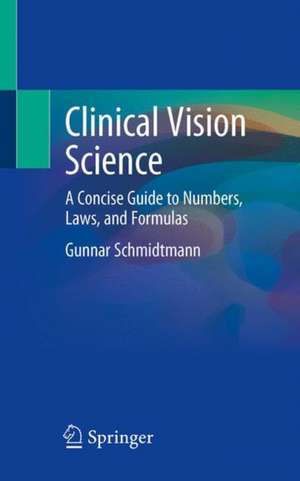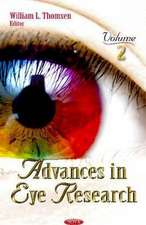Clinical Vision Science: A Concise Guide to Numbers, Laws, and Formulas
Autor Gunnar Schmidtmannen Limba Engleză Paperback – 17 apr 2020
Clinical Vision Science: A Concise Guide to Numbers, Laws, and Formulas is clearly structured into basics, physical optics, visual optics and ophthalmic lenses, optical instruments, photometry, visual perception, clinical procedures, and anatomy & binocular vision. Each chapter contains a range of tables, formulas, large illustrations and flow charts to allow readers to quickly and accurately find key facts for each type of examination procedure.
Preț: 467.93 lei
Preț vechi: 492.56 lei
-5% Nou
Puncte Express: 702
Preț estimativ în valută:
89.53€ • 93.49$ • 73.94£
89.53€ • 93.49$ • 73.94£
Carte tipărită la comandă
Livrare economică 11-17 aprilie
Preluare comenzi: 021 569.72.76
Specificații
ISBN-13: 9783030353391
ISBN-10: 3030353397
Pagini: 159
Ilustrații: XXII, 159 p. 109 illus., 97 illus. in color.
Dimensiuni: 127 x 203 x 14 mm
Greutate: 0.45 kg
Ediția:1st ed. 2020
Editura: Springer International Publishing
Colecția Springer
Locul publicării:Cham, Switzerland
ISBN-10: 3030353397
Pagini: 159
Ilustrații: XXII, 159 p. 109 illus., 97 illus. in color.
Dimensiuni: 127 x 203 x 14 mm
Greutate: 0.45 kg
Ediția:1st ed. 2020
Editura: Springer International Publishing
Colecția Springer
Locul publicării:Cham, Switzerland
Cuprins
Basics .- Trigonometry.- Angular Measures.- Degree to Radians.- Radians to Degree.- The Metric System.- International System of Units.- Important Units.- Physical Optics.- Nature of Light.- Reflection.- Reflection on plane surfaces.- Reflection on curved surfaces.- Important equations.- Refraction.- Refractive Index.- Snell’s Law.- Total Internal Reflection.- Refraction by Prisms.- Refraction on curved surfaces.- Important equations.- Step along method.- The power of a lens system.- Thick Lenses .- Photometry.- Flat angles.- Solid angles.- Inverse Square Law.- Cosine Law.- Optical Instruments.- Camera.- Magnification - The Simple Magnifier.- Entrance and Exit Pupils.- Visual Optics & Ophthalmic Lenses.- Calculating the Sag.- Lens meter equation.- Toric Transposition.- Astigmatism & Cylindrical Lenses.- Toric Lenses.- Oblique Crossed Cylinders.- Accommodation & Vergence.- Accommodation.- Vergence.- Prisms.- Prism Dioptre.- Prism Notation.- Prentice Rule.- The prismatic effect of a sphero-cylindrical lens.- Ophthalmic Lenses.- Types of Lenses.- Lens Materials.- Dispersion and Abbe Number.- Transverse Chromatic Aberration.- Eye Models.- Gullstrand’s Reduced Schematic Eye.- Gullstrand’s Simplified Schematic Eye.- Gullstrand’s Exact Schematic Eye.- Retinal Blur Circle.- Spectacle Magnification.- Visual Perception.- Visual Acuity.- Contrast.- Weber Contrast.- Michelson Contrast.- Root Mean Square (RMS) Contrast.- Sensation & Perception.- Weber’s Law.- Fechner’s Law.- Steven’s Power Law.- Ricco’s Law.- Bloch’s Law.- Piper’s Law.- Ocular Anatomy.- The Anatomy of the Orbit.- The Anatomy of the Eye.- The external Eye & Eye Muscles.- The internal Eye & Retina.- Ocular Diseases & Ocular Pharmacology.- Summary of Common Ocular Diseases.- List of Common Drugs, Dosages, Indications & Contraindications.- Clinical Procedures.- Direct Ophthalmoscopy.- Retinoscopy.- Subjective Refraction.- Fan & Block.- Jackson Cross Cylinder Technique.- Near Vision & Accommodation.- Distance and Near Acuity Chart.- Binocular Vision & Orthoptics.- Definitions: Eso, Exo, Hypo, Hyper.- Phoria vs Tropia.- Extraocular Muscles.- Directions of maximal action for Extrocular Muscles.- Primary and secondary actions.- Adduction.- Abduction.- Incyclo.- Excyclo.- Hering’s Law.- Sherrington’s Law.- Sheard’s Criterion.- Cranial Nerves and Eye Muscles.- Cover-Uncover & Alternate Cover Test.- Hess Chart interpretation.- Difference between Concomitance and Incomitance.- Order of Muscle Sequelae.- Assessment of Motor Fusion.- Prism Corrections.- Crossed and Uncrossed Diplopia.- Bielschowsky Head Tilt Test.- Diagnostic Techniques.- Slit Lamp Biomicroscopy.- Diffuse Illumination.- Sclerotic Scatter.- Direct Illumination.- Indirect Illumination.- Retro Illumination.- Specular Reflection.- Mire Reverse.- Van Herick’s Technique.- Gonioscopy.- Keratometry.- Tonometry.- Perimetry.- Contact Lenses.- Keratometry and Contact lenses.- Contact Lens Materials.- Calculations.- Base Curve.- Diameter.- Back Vertex Power.- Fitting & Assessment of Contact Lenses.- Low Vision.- Assessment of Visual Function.- Assessment of Function Vision.- Magnification.- Field of View.
Notă biografică
Dr Gunnar Schmidtmann is a lecturer in Optometry and joined the University of Plymouth in September 2017. Between 2009 and 2013, he completed a PhD in visual neuroscience at Glasgow Caledonian University (Scotland). For his postgraduate studies, he investigated aspects of shape and contour perception. He continued with this line of research as a postdoctoral research fellow at the McGill Vision Research Unit at McGill University (Montreal, Canada) between 2013 and 2016. He subsequently joined the Laboratory for Integrative Neuroscience at McGill University to investigate the visual functions of patients with traumatic brain injuries and stroke; research that involved the application of brain imaging techniques. His research interests range from computational modeling of the human visual system to understand shape perception to face perception, and clinical studies on the consequences of traumatic brain injuries on visual function.
Textul de pe ultima copertă
This book provides a concise and user-friendly guide to the most common and important numbers, laws and formulas in clinical vision science. Clinicians and trainees in ophthalmology, optometry, orthoptics, and ophthalmic dispensing, who are seeking an easy-to-use lab coat pocket size resource, will find this book to be an essential reference in clinical practice.
Clinical Vision Science: A Concise Guide to Numbers, Laws, and Formulas is clearly structured into basics, physical optics, visual optics and ophthalmic lenses, optical instruments, photometry, visual perception, clinical procedures, and anatomy & binocular vision. Each chapter contains a range of tables, formulas, large illustrations and flow charts to allow readers to quickly and accurately find key facts for each type of examination procedure.
Clinical Vision Science: A Concise Guide to Numbers, Laws, and Formulas is clearly structured into basics, physical optics, visual optics and ophthalmic lenses, optical instruments, photometry, visual perception, clinical procedures, and anatomy & binocular vision. Each chapter contains a range of tables, formulas, large illustrations and flow charts to allow readers to quickly and accurately find key facts for each type of examination procedure.
Caracteristici
Concise guide to applying complex numbers, laws and formulas in clinical practice
Highly illustrated to present complex concepts in a clear and visual format
Includes overviews of various examination techniques and procedures
Highly illustrated to present complex concepts in a clear and visual format
Includes overviews of various examination techniques and procedures






















